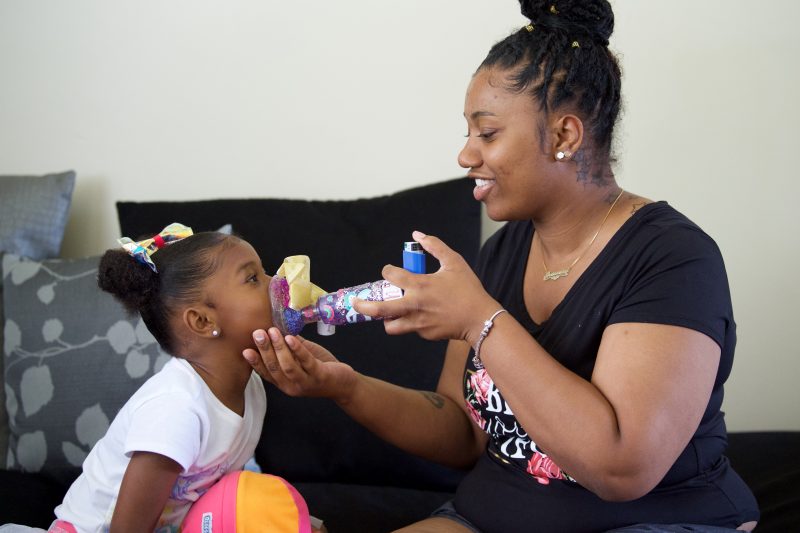
Nyla Johnson practices using an inhaler with a spacer on her stuffed bear with the help of her mother.
According to the American Lung Association, asthma is the most common chronic condition in children, affecting 6.1 million children under 18 in the U.S. If your child is part of this group, Lisa Sammon, DO, pediatric allergist/immunologist at Akron Children’s says being prepared is the best way to manage asthma and reduce severe complications.
“Knowledge is key to controlling one’s asthma, including knowing triggers, medications and what to do if your child has an asthma attack. Education and awareness help keep kids ahead of asthma symptoms,” said Dr. Sammon. “Our asthma action plans are designed to help parents understand what to do in the event of worsening symptoms. We review the plan at our visits to ensure parents are comfortable with each step.”

Dr. Lisa Sammon is a pediatric allergist/immunologist at Akron Children’s where she helps kids with allergies, asthma and other diseases related to a dysfunction of the immune system.
Asthma action plans list actions to take based on a child’s specific needs. They are typically color coded to ensure anyone can easily understand what to do based on how a child is feeling. For example:
- Green – a child is breathing comfortably so daily controller medications are given to keep everything in check.
- Yellow – symptoms such as cough, wheezing or encountering a known trigger occur so additional medication or attention should be taken.
- Red – a child is breathing hard/fast and immediate medical attention is needed.
The asthma action plan will include details about how much medicine to take, when/how often to take it and what to do if symptoms are not improving or getting worse. The plan should go everywhere your child goes. Keep a copy at home, at school and with anyone who cares for your child. Explain the plan to others so they’re comfortable following it.

Nyla Johnson uses her inhaler to keep her asthma under control.
Dr. Sammon suggests parents monitor asthma symptoms and medication used in the plan and discuss concerns with a provider every 6 months. Items to discuss at check-ups may include:
Changes: Keep a journal of the time, place and trigger that may have caused a reaction or asthma flare-up. Allergies and triggers can change over time so on-going self monitoring is important in helping a provider adjust a treatment plan.
Medication type and use: Make sure you have, and are using, the right medications to treat your child’s symptoms. Inhalers remain the best way to use asthma medications, but using an inhaler can be complicated. Ask a provider to demonstrate how to use one or refresh your skills by watching this video.
Avoidance and prevention: Ask for guidance to help your child understand asthma triggers and how to avoid them. For kids who are eligible for flu and COVID-19 shots, vaccines can help prevent severe infection and complications from viruses.
The best defense for asthma sufferers is being prepared and keeping asthma under control. To learn more about asthma action plans, schedule an appointment with the Center for Allergy and Immunology by calling 330-KID-APPT.










